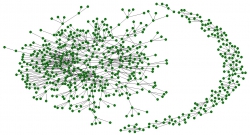Mar
30
2015

Written by Tina Law
There is growing recognition among nonprofits and funders that networks can play a distinct role in advancing social change. As noted by Network Impact and Center for Evaluation Innovation in their recent co-authored paper, networks may be uniquely equipped to tackle challenges that are too complex for individual organizations to address alone, reduce duplication, and spur innovation. To add to this growing literature, we set out to explore the emerging network of nonprofit organizations in New Mexico in our latest report, Working Towards the Common Good: Findings from the 2014 New Mexico Nonprofit Survey.
The 232 nonprofits that participated in the 2014 New Mexico Nonprofit Survey are a diverse set of organizations that build and promote the common good in New Mexico—a state that has been hit hard by the Great Recession and faces distinct challenges in terms of education, health, and economic well-being. The organizations differ in many ways, including their main focus (i.e., direct service, advocacy, community organizing), target populations (i.e., youth, families, Native American communities), and key issue areas (i.e., education, health, youth development). Collectively, these organizations address over 35 different issues facing communities in all of the state’s 33 counties. In particular, these organizations serve as a key resource for the state’s most vulnerable populations, especially individuals living at or below the poverty line and children, youth, and families.
Recognizing that organizations do not exist in isolation but rather as part of a broader network of interdependent groups, we asked survey participants to identify their five closest organizational partners. With this information, we were able to map an emerging network of over 600 New Mexico organizations using social network analysis—an approach to understanding relations among a set of actors that uses both quantitative analysis and graphical representation. The image shown here is one visualization of this New Mexico network, where circles represent individual organizations and lines represent the connections between them. Additional network maps and analysis are shared in the full report.
By looking at these organizations in this way, we get a more dynamic picture of how these organizations are actually connected and tend to work with each other. We learned some interesting findings, including:
- A substantial number of New Mexico nonprofits are already part of a loose network of relatively well-connected organizations.
- Direct service providers, advocacy organizations, and community organizing groups often collaborate with each other.
- Nonprofits in New Mexico tend to collaborate across issue areas, not just working with those organizations that are focused on the same issues.
While this social network analysis certainly does not include all New Mexico nonprofits, it does show that nonprofits in the state have great potential to weave together a strong, dynamic, and collaborative network to advance the common good. In fact, we have only illuminated a small fraction of this emerging network’s true potential: our analysis only looked at organizations’ connections to their five closest partners, but organizations report maintaining partnerships with 26 other organizations on average.
More importantly, it shows only one of many ways in which social network analysis—used frequently in studies of health and more recently in studies of social media—could support social justice advocates and organizations to make visible the often invisible work of collaboration, relationship building, and shared leadership. For instance, what might a social network analysis of New Mexico nonprofits look like in a year? How might that differ from one of nonprofits in California, Michigan, Mississippi, or New York? And what might the impact on the ground be if funders invested more in supporting both these emerging networks and the research that makes these connections visible?

One thought on “Mapping an Emerging Network of Nonprofits in New Mexico”
Comments are closed.